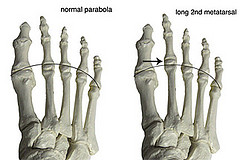Connect With Us
Crossover Toe
 What is a Crossover Toe?
What is a Crossover Toe?
A crossover toe is a progressive condition in which the 2nd toe drifts toward the big toe and eventually crosses over and lays on top of the big toe. In the very early stages of a crossover toe is the best time to begin treatment. Left untreated, the toe begins to shift and cause more severe pain and shoe gear irritation. The toe eventually becomes dislocated, requiring surgery to repair.
What are the symptoms of a Crossover Toe?
- Pain. Pain with a Crossover Toe typically occurs in the ball of the foot. It may feel like there’s a rock or pebble in the shoe, or that the sock is scrunched up.
- Swelling. Swelling in the ball of the foot or on top of the joint may occur.
- Difficulty wearing shoes. In the beginning stages of Crossover Toe, shoes that put you on the ball of the foot begin to become painful. These include high heels, wedges or dress shoes with a heel. In the later stages of Crossover Toe, when the 2nd toe is on top of the big toe, shoes begin to become painful due to irritation.
 What causes Crossover Toe?
What causes Crossover Toe?
Crossover Toe can happen secondary to a traumatic injury to the ligament holding the 2nd toe in place, but more commonly is due to the biomechanics of the foot. A long 2nd metatarsal means excessive pressure at that joint level. When the ball of the foot beneath the 2nd metatarsal takes an excessive amount of weight-bearing pressure, this weakens the supportive ligaments holding the 2nd toe in place. This weakening leads to failure of the joint to stabilize the toe, resulting in the toe crossing over.
Treatment for Crossover Toe
The best time to treat Crossover Toe is in its early stages, when there is pain, but no visible shifting of the toe. Conservative Treatments Include:
- Rest and Ice.
- Oral medications (such as non-steroidal anti-inflammatories). (Note: Please ask your physician before taking any medications).
- Immobilization.
- Splinting/Taping. This may help hold the toe in a corrected position, preventing progression of the deformity.
- Stretching.
- Shoe modifications.
- Orthotic devices. Prescription orthotics with metatarsal pads can help redistribute the weight across all of the lesser joints, lessening the pressure on the 2nd metatarsal/toe joint.
Surgical correction of the deformity may be warranted if the above conservative therapies fail. The toe will never go back to its normal position unless surgery is performed. Contact on of the Foot and Ankle Specialists at Academy Foot and Ankle Specialists to see what treatment or combination of treatments might be right for you.
